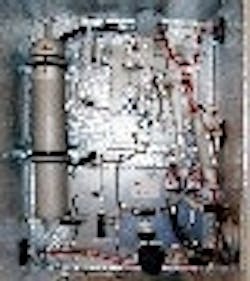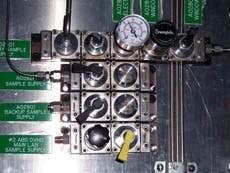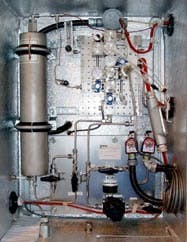NeSSI taxis for takeoff
Is it soup yet? That’s the question that cooks and process control engineers must always ask and answer, and it leads to three follow ups—how good is my data? How soon can I get it? And, how much is it going to cost me?
Answering those questions is the goal, and meeting it is what the New Sampling/Sensor Initiative (NeSSI), its resulting ISA/ANSI SP76.00.02 standard, and its modular components reportedly do for process sampling systems. However, until now, there were few specific examples of NeSSI delivering its promised tens of percent improvements in installation time, reduced footprint and hardware, more efficient maintenance, fewer system leaks, better quality sampling data and greater uptime. Now a few end users and engineers finally are confirming the benefits gained by using this highly modular and reusable technology.
Aiding Installation, Maintenance
INEOS Nitriles in Green Lake, Texas, has always produced acrylonitrile, a monomer for making plastics and nylon products. This process historically requires continual sampling to help turn raw propylene, ammonia, acetone and butane into finished acrylonitrile, acetonenitrile, acetone cyanohydrin and MAH catalyst.
However, a global comparison of all INEOS’ sites revealed in 2000 that Green Lake had two to four times as many analyzers as the chemical company’s other sites, according to Michael Hoffman, INEOS’ analyzer specialist. This high ratio of technicians to analyzer-unit-equivalents meant that proper maintenance might not be happening because staff had to spend too much time cleaning sample systems fouled by the analytical process, and manually performing tasks that should have been automated.
These problems inspired INEOS to seek and develop better sampling systems, which led it to the NeSSI and its SP76 standardized, flexible, reusable Generation 1 substrate and modules. Consequently, INEOS early adopted Swagelok’s MPC NeSSI-compliant components, which allow complex component layering on its substrate. These components already have been operating for several years in a few sampling applications.
First, INEOS’ engineers installed NeSSI modules and ¼-in. valves on two continuous emission monitoring system (CEMS) panels. The first panel took two men seven days to demolish and assemble because of its complex design layout, while the second took the pair three days, and reduced the panel’s footprint by 50%. One of the panels’ sections shrank from 8 sq ft to just 2 in. x 14 in.
INEOS Nitriles implemented a high-volume bypass to reduce maintenance on its reactor off-gas system using Swagelok’s MPC NeSSI-compliant substrate and modules.
Technicians also implemented NeSSI hardware on INEOS’ reactor off-gas system (See Figure 1) that previously needed filters changed twice a week because its galvanic cells would foul easily. The techs built a high-volume bypass, which enabled conditioning only of samples going to the analyzer, and lengthened the time between filter replacements to 45 days to 60 days. The bypass also allowed line clearing without risking exposure to staff. Laser technology is used for 30-day calibration. Changing and calibrating filters takes less than 30 minutes. Though MPC was 7% to 10% more costly than traditional sampling components, the new off-gas system’s installation was 50% faster, its footprint shrank by 50% and its required maintenance was reduced.
Next, after an unexpected hard failure of a primary gas analyzer, INEOS used its small, on-site inventory of MPC parts to help install a backup analyzer in just 2.5 hours. Hoffman says installing this many devices in such a short time would have been very difficult with traditional components.
Finally, INEOS also used a NeSSI-based optical flow cell developed by Applied Analytics Inc. to reduce the footprint of an optical measurement system to 1.6 in. x 7.75 in., which means it only requires an external flow controller. The facility also is integrating Horiba’s mass flow controllers for liquid and gas and Emerson Process Management’s flow controllers into its NeSSI systems.
“Despite these gains, there are still many people resisting and not wanting to consider NeSSI because they don’t want to expose themselves to the potential that a new sampling system might not work,” adds Hoffman. “However, the benefits outweigh the exposure, and there is no exposure and no problems if implementation is done properly upfront.”
Analyzer Accuracy = Trust
Because butyl rubber manufacturing is a sensitive process and because traditional sample handling systems (SHSs) have accuracy problems, engineers are skeptical of the data they get from on-line moisture analyzers via distributed control systems (DCS), says Jamie Canton, analyzer specialist at Lanxess Inc..
For example, moisture analysis systems at Lanxess’ butyl plant in Sarnia, Ontario, previously needed high flow rates and fast loops to deliver representative process parts per million (PPM) moisture conditions to the analyzer, but these rates also increased sample delivery lag times. This happened because high steam-trace energy was needed to prevent moisture absorption on the sample transport pipe wall, which caused subsequent steam-related failures and SHS and analyzer downtime. In addition, because operators could view the moisture analyzer’s data via the DCS, but were blind to the SHS, they typically ordered manual inspections for both, which could take as long as six hours. “These time lags were extremely costly sometimes because moisture levels exceeded specification, resulting in poor product quality and extended plant downtime,” explains Canton.
Then, while improving nine gas chromatographs (GCs) at the Sarnia plant, its engineers began seeking way to increase trust in their moisture analyzer’s data and their confidence in acting on it. Lanxess’ engineers subsequently selected NeSSI-based components, including Parker Hannifin’s IntraFlow and R-Max air-actuated (DBB) stream switching system, which enabled remote validation and multi-stream analysis of one analyzer.
Canton adds that the plant’s butyl moisture sampling system now includes two membrane separators to protect the analyzer from costly flooding due to heat-trace failures. Nitrogen reference gas is dried in an on-board desiccant drier, and is used for calibration and verification. A normally closed (NC) R-Max switch direct sample flow to the analyzer, while a normally open (NO) R-Max directs the standard reference to it. In addition, bypass and analyzer flow indication is performed by Honeywell Sensotec’s 1 psig differential pressure (dP) sensors that measure pressure drops across restricted orifice plates. The sensor’s transmitter sends a 4-20 mA output to the DCS to show flow conditions (See Figure 2).
Lanxess Inc. learned to trust the moisture analyzer in its butyl rubber process by securing better flow signal data with help from Parker Hannifin’s NeSSI-based IntraFlow valve switches.
“Resulting high-quality bypass flow signals and ‘OK to use analyzer data’ signals from the DCS eliminated costly lab sample validations and reduced time that technicians previously spent checking properly functioning systems,” says Canton. “Understanding signal limits and normal event signatures gave us benchmarks of normal operating conditions, so we’ve also established a library of abnormal condition signatures and corrective actions. Since start up the system has posted a 100% uptime record, and the analyzers’ data is regarded as absolute and conclusive.”
Canton adds the plant’s new sampling system recently proved its worth when an unexpected moisture event was found by Lanxess’ control operators, and they learned that the analyzer detected and reported the same uncharacteristic moisture condition via the analyzer’s sample flow indicator over the DCS. “The operators reported this event would have caused a costly plant shutdown if it had happened before their new sampling tools were installed,” he says.
[Editor's note: To read the online white paper, CLICK HERE.]




